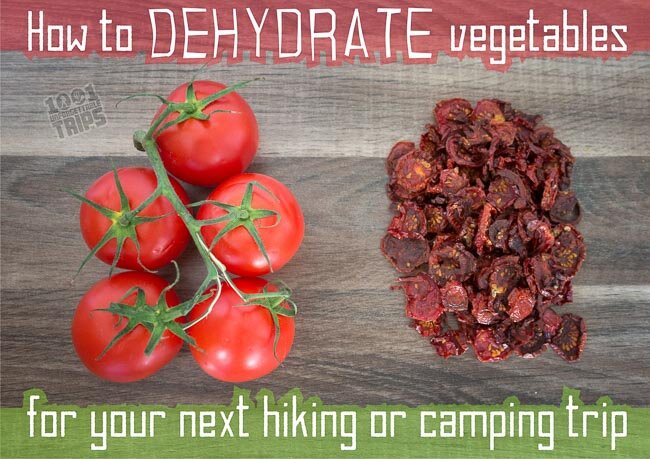
How to dehydrate vegetables for your next hiking or camping trip
Two months ago Boji and I were in the final stages of preparing for an 11-day trek along Corsica’s legendary GR20. Known as the toughest hiking trail in Europe, the GR20 follows along rough and very steep mountain paths, so minimizing the weight of our backpacks was very important. Many hikers achieve this by sleeping and eating in the mountain huts, but we decided to carry our own tent and to cook our own food. So we had to reduce the weight on our packs using different methods…
At home Boji and I love cooking healthy food using fresh vegetables in almost every dish. But fresh vegetables are heavy and take a lot of space, are not as durable and nutritious as compact high-calorie food. So initially they don’t appear to be well-suited as camping food. But:
- We didn’t want to give up on the taste and health benefits of vegetables.
- We wanted to avoid instant soups, instant rice and noodle products or cheap sauce powders from the grocery store, since these mostly contain additives and chemical ingredients like artificial color and flavor, excessive salt, preservatives and hydrogenated oils.
- The prices of lightweight ready-to-eat dehydrated or freeze-dried meals from outdoor companies seemed quite steep if we calculated how much we would need for the two of us on our 11-day trip. Here are some price examples for one hearty main meal: The Outdoor Trail (6 €), travellunch (4 — 7,50 €), Farmers Outdoor (5 — 8 €), Survivor (8 — 10 €), Trek n Eat (6 — 8,5 €), Mountain House (7 €), Expedition food (9 €).
I think I can already reveal that dehydrated vegetables worked perfectly for us. In just a few simple steps I turned 1360 grams of vegetables into 136 grams of concentrated goodness. All that for the price of a single prepackaged meal, at 10% of the original weight and many real vitamins preserved!

What is dehydration?
Dehydration is a drying method by which the majority of the moisture is removed from vegetables or other food in order to preserve them. The magic happens by using the right combination of:
- mild temperature, which causes the moisture to evaporate,
- low humidity, which allows moisture to move quickly from the food into the air,
- constant ventilation, which speeds up the drying by moving the moist air away from the food.
The moisture content in dehydrated vegetables is so low (around 10%) that microorganisms like bacteria, yeast and mold cannot grow. This way your dried vegetables remain edible for at least a year.
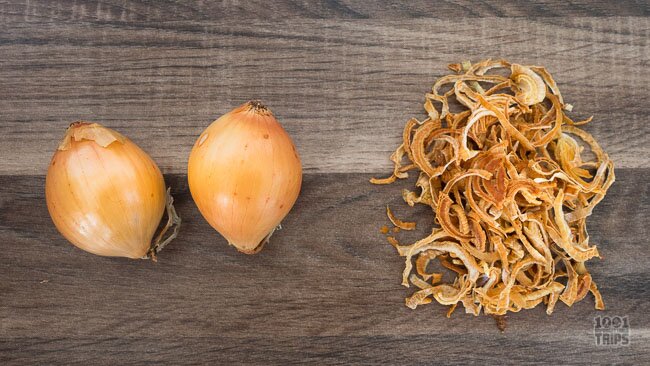
149 g fresh onions turned into 21 g dehydrated onions
Why dehydrate vegetables?
On the first day of our hiking on the GR20 we had to master a 1300 m ascent during a 7-hour hike with our backpacks loaded to the fullest. So the main motivation for drying vegetables at home is:
- to save weight and volume because you’re leaving on a long-distance hiking trip or on a tour with strenuous high-elevation gains.
- if you cannot stock up on fresh vegetables on longer camping or hiking trips.
- if you want to avoid unhealthy food additives often contained in inexpensive “just add water” products.
Advantages
Vegetables are a great source of vitamins, minerals and fiber and thus important for our health. Despite the loss of some nutrients during dehydration (see “Disadvantages”), they still provide lots of goodies which your body needs during longer outdoor activities.
Dehydrated vegetables:
- are lightweight because 90% of the water (which is their biggest weight factor) has been removed,
- don’t take much space, because they shrink to about 10 % of their initial size,
- don’t go bad even during the longest hiking trip,
- add variety to your outdoor cuisine: instead of limiting yourself to boring and (usually unhealthy) packaged food you can add a healthy and colorful component to any outdoor meal.
- are already cut and quick to prepare, which is especially great in cold weather when you don’t want to spend much time with food preparation,
- are real vegetables from mother nature and no chemical substitutes. However note that commercially dried veggies often contain various chemical additives.
Disadvantages
The nutrient content of vegetables starts decreasing as soon as they are separated from the plant, and then it continues to decline as the vegetables are stored, exposed to light and air, peeled, sliced, and of course cooked. Even dehydration causes , however due to the low heat used with indoor dehydration methods (oven or dehydrator), the nutrient loss is much lower than when drying in the sun. Pre-treating the vegetable before drying helps to retain some vitamins (see section “Blanching” below).
Further minor downsides to dehydration are:
- Dehydration is an extra step which you have to plan and implement before you start your trip. However it’s not that much: I bought the veggies for our camping trip on my way home from work, then it took me about 30 min to wash and cut them. Once in the oven, I had to check the temperature and stir them occasionally over a period of several hours.
- If the vegetables are kept in the oven for too long or the temperature is too high, their structure will change permanently and they will not expand again when you soak or cook them.
- The flavor of dried vegetables is slightly different from that of their fresh counterparts.
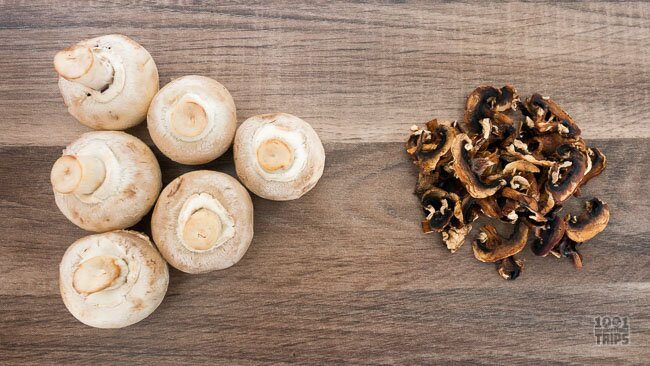
122 g fresh mushrooms turned into 12 g dehydrated mushrooms
Dehydration Methods
Sun drying
To prevent mold growth while drying vegetables you need very hot and dry air, which is not the case in countries with moderate climate like Germany.
Electrical food dehydrators
(in German ) let you adjust the temperature precisely and continuously exchange the humid air inside with dry air from the outside. They are very efficient and use less electricity than an oven, but they cost money and take extra space in your kitchen.But if you plan on dehydrating large quantities of fruits and vegetables, the investment might be well worth.
Conventional oven
The simplest way to dry food is to use your kitchen oven. It’s slower and uses more energy because its fan is not optimized for ventilation of outside air, but for casual veggie dryers like me (who intend to make only a few batches a year) it’s still the best option.
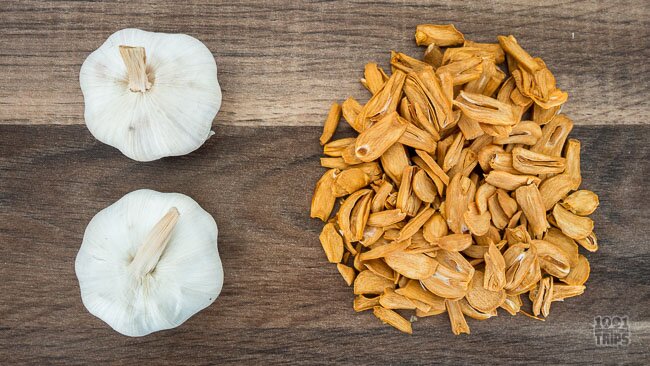
80 g fresh garlic turned into 26 g dehydrated garlic
Special topic: Blanching or Steaming
Dehydration won’t stop enzyme activity (the heat it too low), so in order to keep as much of the taste and color of your dried vegetables, you should blanch them before dehydration. Blanching even helps to protect certain nutrients which would normally be destroyed by straightforward dehydration.
is the process of holding vegetables, fruits or nuts in boiling water for 30 seconds up to a couple of minutes, then cooling them down quickly by immersing them in ice cubes or washing them off with cold water. A nice side-effect of blanching is that it shortens the drying (and later the re-hydration) process because it relaxes the tissue walls so moisture can escape more rapidly.
Blanching protects most nutrients, but vitamin C is lost because it dissolves into the water. Steaming (instead of blanching) minimizes the loss of water-soluble vitamins, but it’s more time-consuming.
Except for mushrooms, peppers, zucchini, tomatoes, onions, garlic, okra, asparagus and fennel all other veggies should be blanched.
Special topic: Dehydrating deep-frozen vegetables
If you are preparing for a winter trip and cannot find fresh vegetables on the market, you can start with deep-frozen veggies from the supermarket. One positive thing is that they are already washed, cut and blanched, which saves you some work. But more importantly, they were probably harvested in season and a ripe state and processed within a few hours, so they most likely contain more nutrients than “winter vegetables” (picked unripe many days ago, then transported from far-away countries to your local supermarket).
The procedure for dehydrating frozen veggies is identical to starting with fresh ones (see below), but obviously it will take a bit longer than normal.
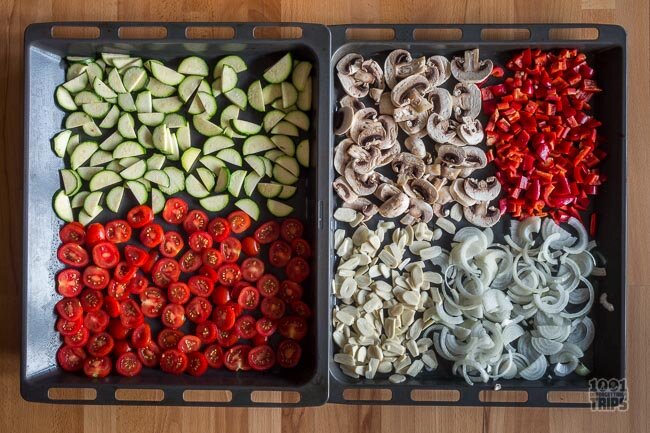
This arrangement is just for demonstration purpose. In reality I distributed the veggies on three layers inside the oven.
How to dehydrate vegetables in your home oven
The process is quite straightforward, but to get optimal results there are a few simple rules to follow. We’ve prepared a beautiful 1-page PDF which describes the entire process in 9 easy steps.
To get the free PDF simply .
On average only 10 % of the original weight remains, but the “winner” is dehydrated zucchini, with only 5% of the weight and size of the original product:
| Vegetable | Original Weight (g) | Dehydrated Weight (g) | Remaining Weight | Weight Loss |
|---|---|---|---|---|
| Zucchini | 355 | 16 | 5% | 95% |
| Tomatoes | 480 | 39 | 8% | 92% |
| Bell peppers | 174 | 17 | 10% | 90% |
| Mushrooms | 122 | 12 | 10% | 90% |
| Onions | 149 | 21 | 14% | 86% |
| Garlic | 80 | 26 | 33% | 67% |
| Sum | 1360 | 131 | 10% | 90% |
I chose these types of vegetables because they fit the meals that I had planned, but also because none of them required blanching.
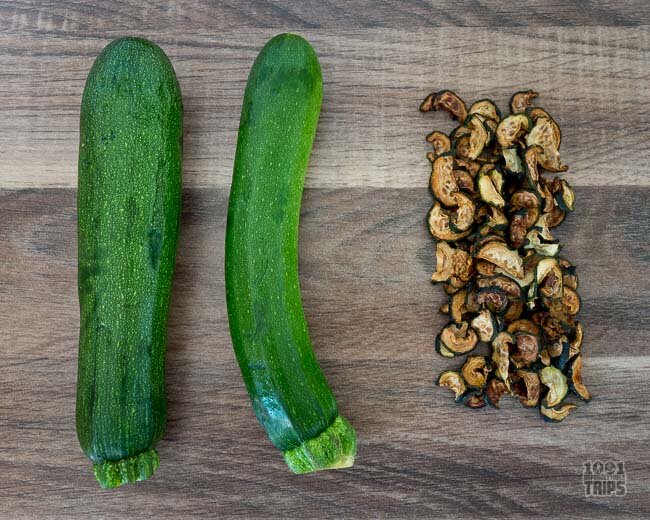
355 g fresh zucchini turned into 16 g dehydrated zucchini
Storage
You can store your dehydrated veggies in an airtight and moisture-proof container or in a ziplock bag as a lightweight alternative. Keep the container in a dry and dark location and the veggies will remain “fresh” for at least a year. Or keep it in the fridge to extend this period even further.
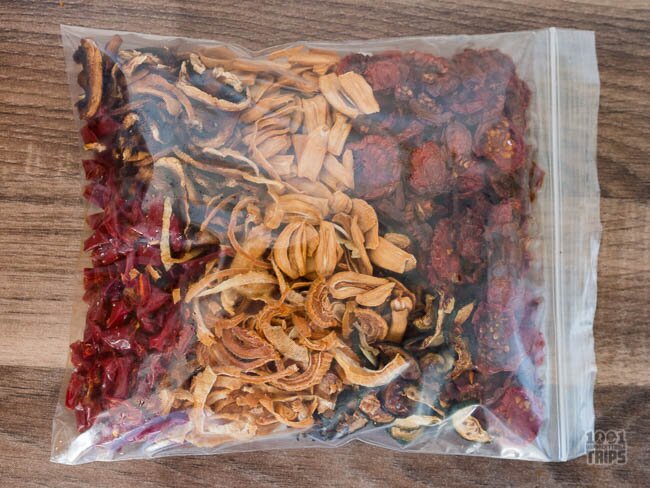
Store the dry veggies in a zip-lock bag and protect them from the sun.
How to cook with dehydrated vegetables
Many pages on the Internet recommend to rehydrate your dehydrated vegetables before cooking a meal with them. Simply add hot water in 5:1 ratio, then wait 0,5 — 2 hours (depending on the vegetables).
While this sounds completely reasonable, on our Corsica trip we were quite hungry each evening, so we added the dried vegetables directly to the pot and simmered them for 15–20 minutes together with the couscous, bulgur or lentils. We then waited for another 5 minutes for the meal to cool down, and this worked very well for us. Our meals were exceptionally tasty (check our next articles for recipes and more tips and tricks), and we never had the feeling that the veggies are too hard or spongy.
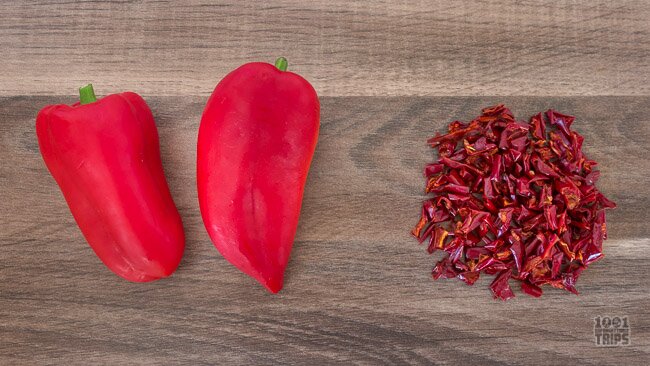
174 g fresh bell pepper turned into 17 g dehydrated pepper
And how about you, dear reader? Have you dehydrated food at home? Please share your experiences with our audience by posting a comment below.




